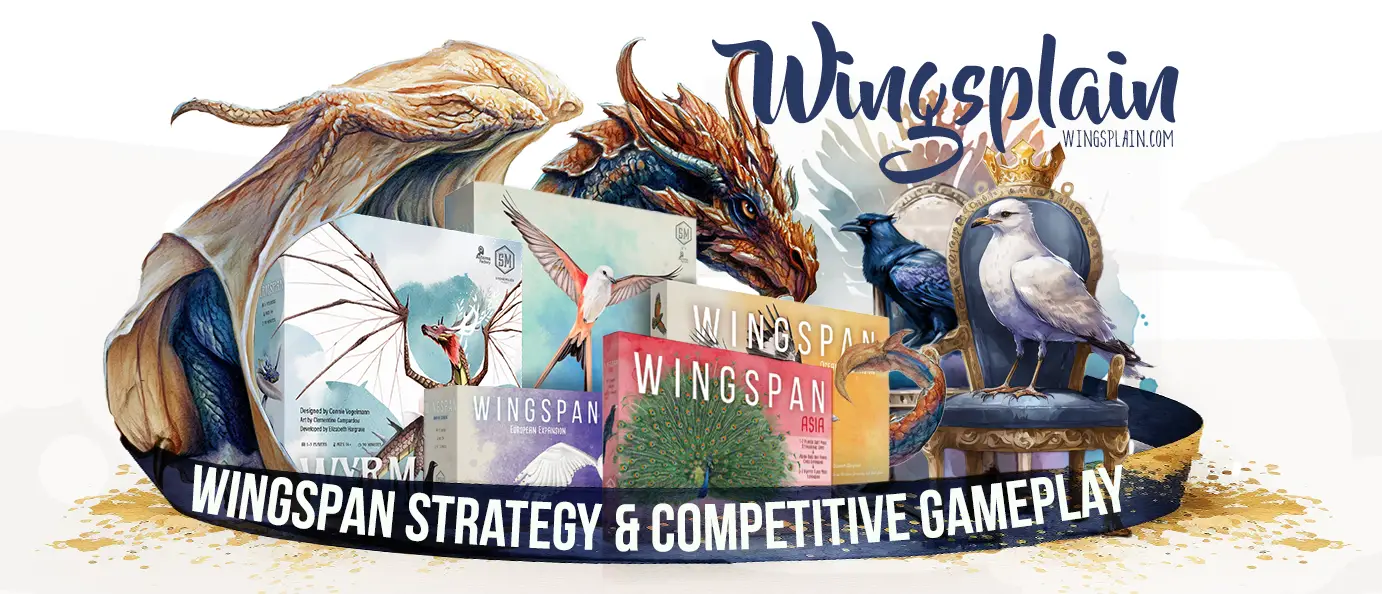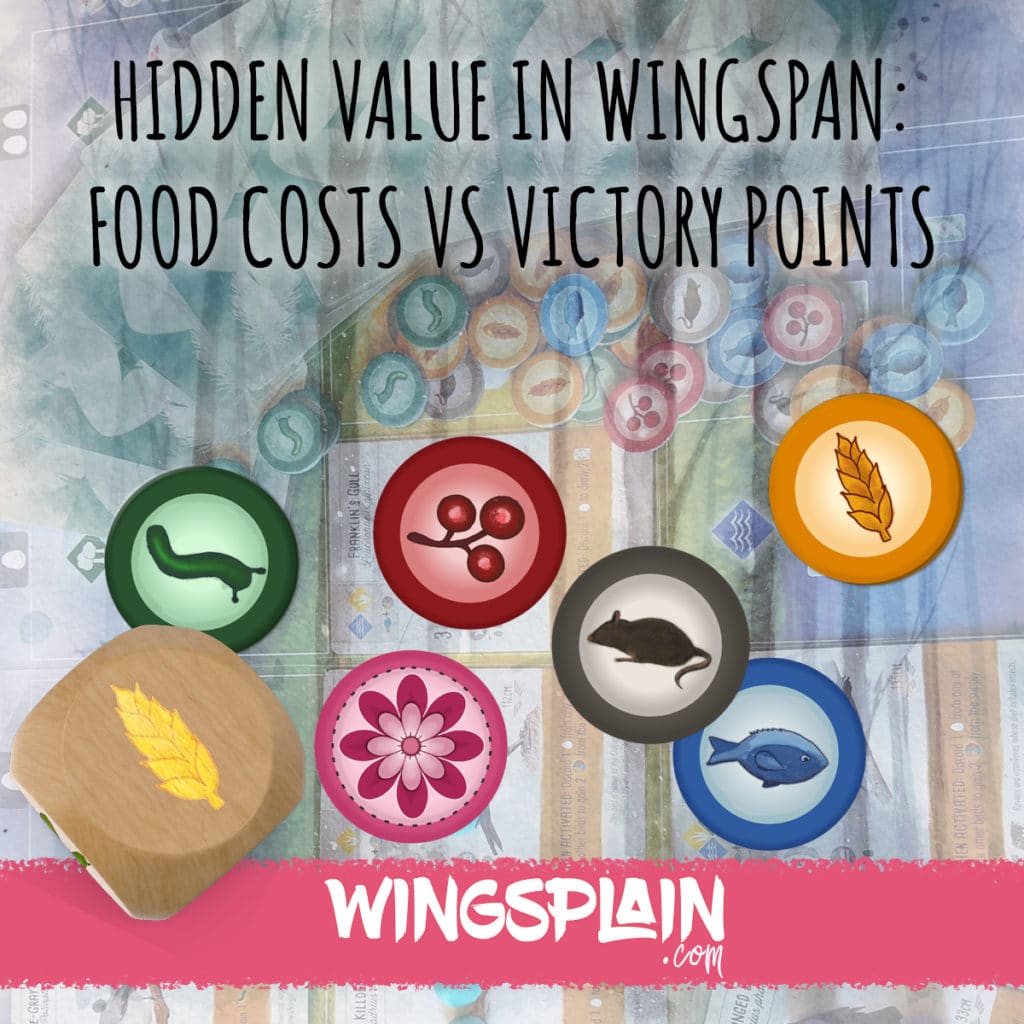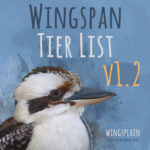What is the best value that one, two, or three food can get you in Wingspan? How many points should you strive to score off each piece of food invested in a bird? I recently asked myself these questions and set out to find the answer. This topic is an important element of Wingspan Strategy.
Some cards are better than others, and one of the deciding factors in those comparisons, obviously, is food costs. I conducted a semi-random audit of the card pool and uncovered some interesting data.
The most obvious food to VP conversions, in my mind, are birds that score five raw points for a single food. Examples include Wilson’s Snipe, Eurasian Nutcracker, and Clark’s Grebe. Considering their nests, we can see that they all fit the archetype of:
5 VP + 2 Eggs = 7 possible total VP
In the case of these birds, a single food can net you seven total victory points if you manage to lay eggs on them. Taking this a step further, let’s look at more birds that cost a single food and see what they can do.
Bird Cards That Cost One Food
| Wingspan Card | Eggs | VP | Tucks | Cache | Points |
|---|---|---|---|---|---|
| Red-Winged Blackbird | 3 | 2 | 3 | 8+ | |
| Wilson's Snipe | 2 | 5 | 7 | ||
| Eurasian Nutcracker | 2 | 5 | X | 7+ | |
| Clark's Grebe | 2 | 5 | 7 | ||
| Common Nightingale | 4 | 3 | 7 | ||
| Common Chiffchaff | 3 | 3 | X | 6+ | |
| Anna's Hummingbird | 2 | 4 | 6 | ||
| Ruby-Throated Hummingbird | 2 | 4 | 6 | ||
| Black-Chinned Hummingbird | 2 | 4 | 6 | ||
| Carolina Chickadee | 3 | 2 | X | 5+ |
I didn’t dig through the entire card pool to analyze all birds that cost a single food, so there may be more (or better) examples that reflect the potential VP yield at this cost. However, what we can see from this sample is that there are a lot of potential points that can be scored over the course of the game from just a single food. I think we can safely make the statement that:
Playing optimally, strive to score at least five points from each piece of food spent from your personal supply.
I make the distinction of your personal supply because that is a finite resource. The general supply is theoretically infinite. Scoring points from your personal supply is harder because you need to take actions to acquire that food, to begin with. Additionally, the only way to play birds is to spend food from your personal supply (with a few notable exceptions). Your personal supply is a valuable and limited resource, so you should strive to maximize its scoring potential.
Bird Cards That Cost Two Food
Can we take this further? Should birds that cost two food score you ten points over the course of the game? There aren’t any birds that score a raw ten points, let alone at a food cost of two. Eggs and powers are going to have to come into play to close the gap. When we consider some of these ideas, we can see the potential of cards like Wilson’s Snipe. While their powers might seem lackluster, scoring five raw victory points right now for a single food is a powerful effect.
Here are some samples of two cost birds and what it takes for them to score ten or more points:
| Wingspan Card | Eggs | VP | Tucks | Cache | Points |
|---|---|---|---|---|---|
| Bushtit | 5 | 2 | 5 | 12+ | |
| House Sparrow | 5 | 6 | X | 11+ | |
| Barn Owl | 4 | 5 | 1 | 10+ | |
| Burrowing Owl | 4 | 5 | 1 | 10+ | |
| Cerulean Warbler | 2 | 4 | 10+ 4 Bonus points scored off acquisition | ||
| Spotted Owl | 1 | 5 | 10+ 4 Bonus points scored off acquisition | ||
| Cassin's Finch | 3 | 4 | 10+ 3 Bonus points scored off acquisition | ||
| Hooded Warbler | 3 | 7 | 10 | ||
| American Coot | 5 | 2 | 3 | 10+ | |
| Canada Goose | 3 | 3 | 4 (2 activations) | 10+ | |
| Audouin's Gull | 2 | 1 | 7 (Strong Power) | 10+ | |
| Baird's Sparrow | 2 | 3 | 10+ 5 Laid Eggs (5 activations) | ||
| Eurasian Collared-Dove | 2 | 5 | X | 7+ |
One interesting bit from this data is that we can see that Cassin’s Finch has one more victory point built into its egg capacity when compared to Cerulean Warbler and Spotted Owl. This means that a whiffed bonus card draw is slightly less detrimental.
We can also see that Barn Owl and Burrowing Owl, despite their generally weak powers, only need to score one successful roll to hit ten victory points (after eggs are laid, of course).
House Sparrow stands apart from its counterpart, Eurasian Collared-Dove. The Sparrow secures eleven VP without its power, while the Dove only secures seven at the same food cost of two. The Dove has the advantage of being far more flexible with its power than the Sparrow does though, using any food to tuck cards instead of only wheat (this gets even better with nectar).
Other cards, like Baird’s Sparrow, need to work harder to get there, but if played early and leaned on often as a core component of an engine, they will eventually hit their optimal value of “five victory points per food spent to play.”
Bird Cards That Cost Three Food
The Rule of Six?
My investigation of three food cost birds led to an interesting discovery. You can see a formula built into the card design of several birds:
Raw VP Total + Max Egg Capacity + 6 Points Scored from a power = 15 points
Observe the following:
| Wingspan Card | Eggs | VP | Tucks | Cache | Points |
|---|---|---|---|---|---|
| Golden Eagle | 1 | 8 | 6 (6 successful activations) | 15 | |
| Atlantic Puffin | 1 | 8 | 15 6 bonus points scored off acquisition | ||
| Painted Bunting | 4 | 5 | 15 6 bonus points scored off acquisition | ||
| Greater Prairie-Chicken | 4 | 5 | 15 6 bonus points scored off acquisition | ||
| Acorn Woodpecker | 4 | 5 | 6 (6 successful activations) | 15 4 bonus points scored off acquisition | |
| Rufous Owl | 2 | 7 | 6 (6 successful activations) | 15 | |
| Little Penguin | 2 | 7 | 6 | 15 | |
| Australian Raven | 3 | 7 | 5 (game end power) | 15 | |
| European Goldfinch | 4 | 6 | 5 (5 successful activations) | 15 | |
| King Rail | 6 | 4 | 15 5 bonus points scored off acquisition | ||
| Galah | 2 | 5 | 8 (4 activations) | 15 | |
| Blyth's Hornbill | 2 | 7 | 12 (when played) | 21 (15 Net) | |
| Wild Turkey | 5 | 8 | 13 | ||
| Bluethroat | 5 | 7 (strong power) | 12 | ||
| American Woodcock | 2 | 9 | 11 | ||
| Lesser Frigatebird | 1 | 9 | 10 | ||
| American Bittern | 2 | 7 | 9 | ||
| Greylag Goose | 2 | 7 | 9 |
I took more samples at this level because I wanted to see how far “the rule of six” went. I didn’t dig much deeper than this, but it was interesting to see this pattern emerge. At this food cost, it can be harder for certain birds to score effectively for the resources invested in them. Bonus Card Birds seem to struggle, as they need to land a six-point or higher bonus card to get the maximum out of the food used to play them. I originally saw how the Puffin fit into this mold and then looked at Painted Bunting and Greater Prairie Chicken to compare. They fit the same mold, which I found pretty interesting.
Acorn Woodpecker surprised me by fitting into this mold as well. I’m not sure I’ve ever decided to play this card when it has come up due to its potential to miss with its power.
Blyth’s Hornbill demonstrates that it’s a monster with a possible 21 point When Played power, but surprisingly enough, it nets fifteen points under its maximum potential.
My audit suggests that fifteen net points scored on the back of a six-point power is a prevalent design for birds at three food cost.
When looking at the “5/10/15” Rule (I think that’s what I’m going to call this philosophy), we see some interesting patterns emerge from the card pool as we consider how to score five points per food invested. This philosophy takes a more focused look at the birds. It suggests that not only should multiple cards work together to build an engine, but the individual cards themselves should strive to produce five points per food invested, becoming mini-engines unto themselves and resulting in the most optimized scores.
See part two of this article here: Discover Hidden Value in Wingspan: The 3/6/9 Scale




Interesting article. Though I am not sure of the value of analysis. Both 5/10/15 & 3/6/9 rules disregard some important considerations:
1. Timing. At the start, you want to focus on engine-building, at the end you focus on points. Expensive birds with lots of points but little utility are a sure-fire way to lose the game, whilst cheap birds with no points but strong resource collecting are probably strong.
2. More resources are involved than just food cost. The bird card need to be drawn. Then playing the bird costs eggs (0-2), which are worth VPs. Then, it costs an action cube to play the bird. Playing 1 3f/9p bird is much easier to play then playing 3 1f/3p birds. Actually, playing a 3f/9p bird can be done as the first move!
3. Playing more birds also gives access to upgraded fields, resulting in more food, cards, eggs.
Disregarding these elemental points, looking at food per victory point is really comparing apples to oranges, and doesn’t provide much insights.